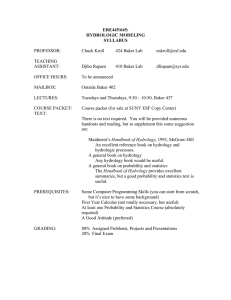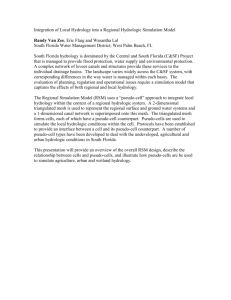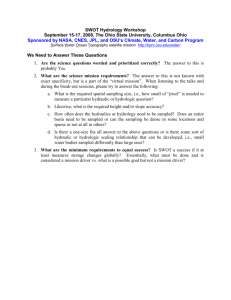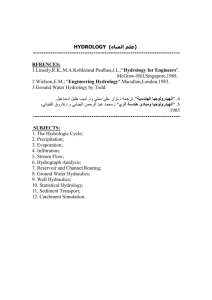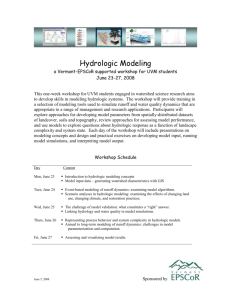ENGINEERING AND C B
advertisement
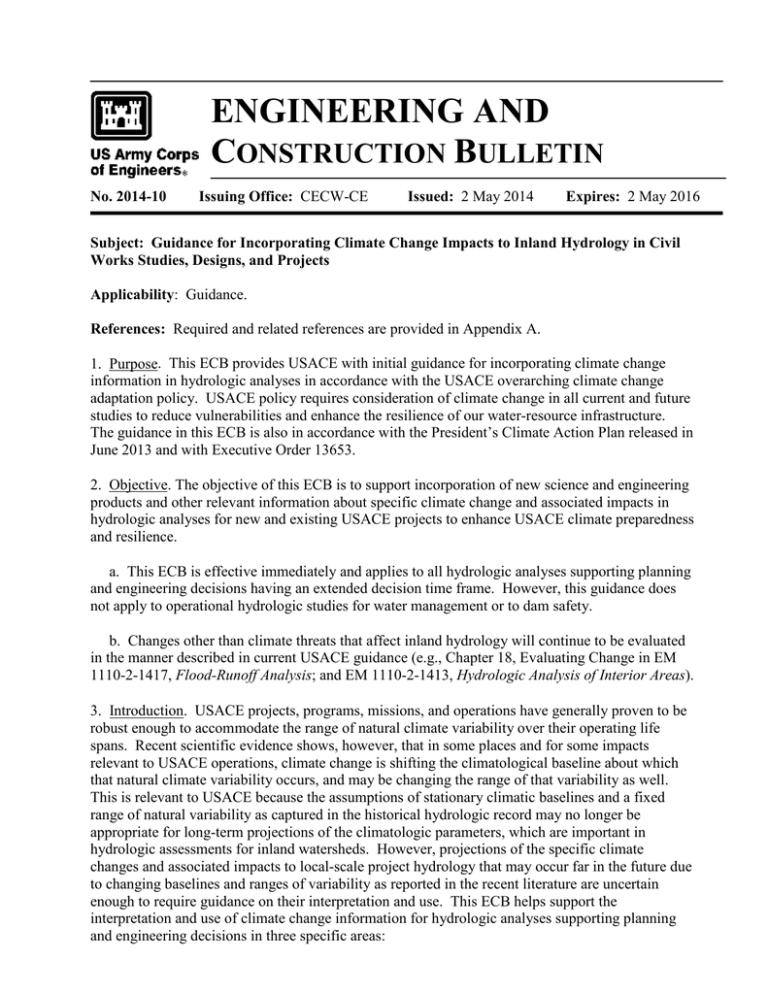
ENGINEERING AND CONSTRUCTION BULLETIN No. 2014-10 Issuing Office: CECW-CE Issued: 2 May 2014 Expires: 2 May 2016 Subject: Guidance for Incorporating Climate Change Impacts to Inland Hydrology in Civil Works Studies, Designs, and Projects Applicability: Guidance. References: Required and related references are provided in Appendix A. 1. Purpose. This ECB provides USACE with initial guidance for incorporating climate change information in hydrologic analyses in accordance with the USACE overarching climate change adaptation policy. USACE policy requires consideration of climate change in all current and future studies to reduce vulnerabilities and enhance the resilience of our water-resource infrastructure. The guidance in this ECB is also in accordance with the President’s Climate Action Plan released in June 2013 and with Executive Order 13653. 2. Objective. The objective of this ECB is to support incorporation of new science and engineering products and other relevant information about specific climate change and associated impacts in hydrologic analyses for new and existing USACE projects to enhance USACE climate preparedness and resilience. a. This ECB is effective immediately and applies to all hydrologic analyses supporting planning and engineering decisions having an extended decision time frame. However, this guidance does not apply to operational hydrologic studies for water management or to dam safety. b. Changes other than climate threats that affect inland hydrology will continue to be evaluated in the manner described in current USACE guidance (e.g., Chapter 18, Evaluating Change in EM 1110-2-1417, Flood-Runoff Analysis; and EM 1110-2-1413, Hydrologic Analysis of Interior Areas). 3. Introduction. USACE projects, programs, missions, and operations have generally proven to be robust enough to accommodate the range of natural climate variability over their operating life spans. Recent scientific evidence shows, however, that in some places and for some impacts relevant to USACE operations, climate change is shifting the climatological baseline about which that natural climate variability occurs, and may be changing the range of that variability as well. This is relevant to USACE because the assumptions of stationary climatic baselines and a fixed range of natural variability as captured in the historical hydrologic record may no longer be appropriate for long-term projections of the climatologic parameters, which are important in hydrologic assessments for inland watersheds. However, projections of the specific climate changes and associated impacts to local-scale project hydrology that may occur far in the future due to changing baselines and ranges of variability as reported in the recent literature are uncertain enough to require guidance on their interpretation and use. This ECB helps support the interpretation and use of climate change information for hydrologic analyses supporting planning and engineering decisions in three specific areas: ECB No. 2014-10 SUBJECT: Guidance for Climate Change Adaptation Engineering Inputs to Inland Hydrology for Civil Works Studies, Designs, and Projects a. A qualitative assessment of potential climate change threats and impacts potentially relevant to the particular USACE hydrologic analysis being performed. b. Resources to support the qualitative assessment of climate threats and impacts specific to those analyses. c. An early overview of future planned guidance for additional quantitative assessments of potential climate change threats and impacts for use in future hydrologic analyses. 4. Incorporating Climate Change and Variability in Hydrologic Analyses. a. Climate change information for hydrologic analyses includes direct changes to hydrology through changes in temperature, precipitation, and other climate variables, as well as subsequent basin responses such as sedimentation loadings potentially altered by changes in those primary climate drivers. The qualitative analysis required by this ECB includes consideration of both past (observed) changes as well as potential future (projected) changes to relevant hydrologic inputs. The results of this qualitative analysis can indicate the direction of change but not necessarily the magnitude of that change. For this reason, the qualitative analysis does not alter the numerical results of the calculations made for the other, non-climate aspects of the required hydrologic analyses. However, the climate change information synthesized and evaluated during the qualitative analysis can inform the decision process related to future without project conditions, formulation and evaluation of the performance of alternative plans, or other decisions related to project planning, engineering, operation, and maintenance. b. The qualitative analysis is the only approach currently required for hydrologic studies for inland watersheds at the time of issuance of this ECB. c. The qualitative analysis will be required for projects except for the following cases: (1) Feasibility Phase: The Tentatively Selected Plan (TSP) milestone has been completed as of the date of issuance of this ECB. (2) Preconstruction Engineering and Design (PED): The required hydrology and hydraulics components of the PED phase are more than 50% complete, as of the date of issuance of this ECB. d. A first-order statistical analysis of the potential impacts to particular hydrologic elements of the study can be included as supplemental input to this qualitative assessment, but is not required. e. Appendix B provides a flow chart of the guidance provided in this ECB. f. Appendix C provides detailed guidance on how to perform the qualitative analysis, as well as an example with a first-order statistical analysis. 2 ECB No. 2014-10 SUBJECT: Guidance for Climate Change Adaptation Engineering Inputs to Inland Hydrology for Civil Works Studies, Designs, and Projects 5. Future Expansion of Support Documents for Implementation of this ECB. A series of guidance documents will be published in the future to support quantitative analyses of climate threats and impacts to specific project types. Appendix D provides a preview of planned future quantitative guidance. 6. HQUSACE POC. The HQUSACE POC for this action is Mr. Jerry Webb, Leader of the Hydrology, Hydraulics, and Coastal Community of Practice, 202-761-0673. Encls //S// JAMES C. DALTON, P.E., SES Chief, Engineering and Construction U.S. Army Corps of Engineers 3 ECB No. 2014-10 SUBJECT: Guidance for Climate Change Adaptation Engineering Inputs to Inland Hydrology for Civil Works Studies, Designs, and Projects Appendix A: References. Barnett, T., D.W. Pierce, H. Hidalgo, C. Bonfils, B.D. Santer, T. Das, G. Bala, A.W. Wood, T. Nazawa, A. Mirin, D. Cayan, and M. Dettinger. 2008. Human-induced changes in the hydrology of the western United States. Science/Science Express Reports, 10.1126/science.1152538. Bonfils, C., B.D. Santer, D.W. Pierce, H.G. Hidalgo, G. Bala, T. Das,…, and T Nozawa. 2008. Detection and attribution of temperature changes in the mountainous western United States. Journal of Climate 21(23), 6404–6424. doi: 10.1175/2008jcli2397.1 Brekke, L.D., M.D. Dettinger, E.P. Maurer, and M. Anderson. 2008. Significance of model credibility in estimating climate projection distributions for regional hydroclimatological risk assessments. Climatic Change 89(3–4), 371–394. Bureau of Reclamation. 2011a. Literature Synthesis on Climate Change Implications for Water and Environmental Resources. Second Edition. Technical Memorandum 86-68210-2010-03. U.S. Department of the Interior, Bureau of Reclamation, Research and Development Office, Denver, CO. http://www.usbr.gov/research/docs/climatechangelitsynthesis.pdf Bureau of Reclamation. 2011b. West-Wide Climate Risk Assessments: Bias-Corrected and Spatially Downscaled Surface Water Projections. Prepared by the U.S. Department of the Interior, Bureau of Reclamation, Technical Services Center, Denver, CO. Cayan, D.R., S.A. Kammerdiener, M.D. Dettinger, J.M. Caprio, and D.H. Peterson. 2001. Changes in the onset of spring in the western United States. Bulletin of the American Meteorological Society 82, 399–415. Christensen, N.S., A.W. Wood, D.P. Lettenmaier, and R.N. Palmer. 2004. Effects of climate change on the hydrology and water resources of the Colorado River Basin. Climatic Change 62 (1–3), 337–363. Christensen, N.S., and D.P. Lettenmaier. 2007. A multimodel ensemble approach to assessment of climate change impacts on the hydrology and water resources of the Colorado River basin. Hydrology and Earth System Sciences 11, 1417–1434. Déry, S.J., M. Stieglitz, E.C. McKenna, and E.F. Wood. 2005. Characteristics and trends of river discharge into Hudson, James, and Ungava Bays, 1964–2000. Journal of Climate 18, 2540– 2557. doi: http://dx.doi.org/10.1175/JCLI3440.1 Dettinger, M.D., and D.R. Cayan. 1995. Large-scale atmospheric forcing of recent trends toward early snowmelt runoff in California. Journal of Climate 8, 606–623. A-1 ECB No. 2014-10 SUBJECT: Guidance for Climate Change Adaptation Engineering Inputs to Inland Hydrology for Civil Works Studies, Designs, and Projects Hegerl, G., and F. Zwiers. 2011. Use of models in detection and attribution of climate change. Wiley Interdisciplinary Reviews: Climate Change 2011. doi: 10.1002/wcc.121 IPCC AR4. 2007. Contribution of Working Groups I, II and III to the Fourth Assessment Report of the Intergovernmental Panel on Climate Change. (R.K. Pachauri and A.Reisinger, Eds.). Intergovernmental Panel on Climate Change, Geneva, Switzerland. Jha, M., J.G. Arnold, F.G. Gassman, and R.R. Gu. 2006. Climate change sensitivity assessment on Upper Mississippi River Basin streamflows using SWAT. Journal of the American Water Resources Association 42(4), 997–1015. Knowles, N., and D.R. Cayan. 2002. Potential effects of global warming on the Sacramento/San Joaquin watershed and the San Francisco estuary. Geophyscial Research Letters, 29(18), 1891. doi: 10.1029/2001gl014339 Knowles, N., M.D. Dettinger, and D.R. Cayan. 2006. Trends in snowfall versus rainfall in the western United States. Journal of Climate 19, 4545–4559. Kundzewicz, Z.W., and A. Robson (Eds.). 2000. Detecting Trends and Other Changes in Hydrological Data. World Climate Programme – Water. United National Educational Scientific and Cultural Organization, World Meteorological Organization, WMO / TD-No. 1013, Geneva, Switzerland. Kunkel, K.E, L.E. Stevens, S.E. Stevens, L. Sun, E. Janssen, D. Wuebbles, M.C. Kruk, D.P. Thomas, M. Shulski, N. Umphlett, K. Hubbard, K. Robbins, L. Romolo, A. Akyuz, T. Pathak, T. Bergantino, and J.G. Dobson. 2013. Regional Climate Trends and Scenarios for the U.S. National Climate Assessment. Part 4. Climate of the U.S. Great Plains. NOAA Technical Report NESDIS 142-4. http://scenarios.globalchange.gov/regions/great-plains Lettenmaier, D.P., and T.Y. Gan. 1990. Hydrologic sensitivities of the Sacramento–San Joaquin River Basin, California, to global warming. Water Resources Research 26: 69–86. Liang, X., D.P. Lettenmaier, E.F. Wood, and S.J. Burges. 1994. A simple hydrologically based model of land surface water and energy fluxes for GSMs. Journal of Geophysical Research 99(D7), 14, 415–428. Maurer, E.P. 2007. Uncertainty in hydrologic impacts of climate change in the Sierra Nevada, California under two emissions scenarios. Climatic Change 82, 309–325. Maurer, E.P., L.D. Brekke, and T. Pruitt. 2010. Contrasting lumped and distributed hydrology models for estimating climate change impacts on California watersheds. Journal of the American Water Resources Association 46(5), 1024–1035. doi: 10.1111/j.17521688.2010.00473.x. A-2 ECB No. 2014-10 SUBJECT: Guidance for Climate Change Adaptation Engineering Inputs to Inland Hydrology for Civil Works Studies, Designs, and Projects McGuire, E.M., and A. Hamlet. 2010. Hydrologic Climate Change Scenarios for the Pacific Northwest Columbia River Basin and Coastal Drainages. Chapter 5. Macro-scale Hydrologic Model Implementation. Available at http://www.hydro.washington.edu/2860/report/. NOAA. 2013. Regional Climate Trends and Scenarios for the U.S. National Climate Assessment. U.S. Department of Commerce, National Oceanic and Atmospheric Administration, National Environmental Satellite Data, and Information Service, Washington, DC. http://www.nesdis.noaa.gov/technical_reports/142_Climate_Scenarios.html Payne, J.T., A.W. Wood, A.F. Hamlet, R.N. Palmer, and D.P. Lettenmaier. 2004. Mitigating the effects of climate change on the water resources of the Columbia River basin. Climatic Change 62(1–3), 233–256. Raff, D.A., T. Pruitt, and L.D. Brekke. 2009. A framework for assessing flood frequency based on climate projection information. Hydrology and Earth System Science Journal 13, 2119–2136. www.hydrol-earth-syst-sci.net/13/2119/2009/ Sklar, F.H., H.C. Fitz, Y. Wu, R. Van Zee, and C. McVoy. 2001. South Florida: The reality of change and the prospects for sustainability: The design of ecological landscape models for Everglades restoration. Ecological Economics 37(3), 379–401. Stewart, I.T., D.R. Cayan, and M.D. Dettinger. 2005. Changes towards earlier streamflow timing across western North America. Journal of Climate 18(8), 1136–1155. Vanrheenen, N.T., A.W. Wood, R.N. Palmer, and D.P. Lettenmaier. 2004. Potential implications of PCM climate change scenarios for Sacramento–San Joaquin River Basin hydrology and water resources. Climatic Change 62, 257–281. Vogel, R.M., C. Yaindl, and M. Walter (2011). Nonstationarity: Flood magnification and recurrence reduction factors in the United States. Journal of the American Water Resources Association 47(3), 464-474. Doi: 10.1111/j.1752-1688.2011.00541.x Wood, A.W., E.P. Maurer, A. Kumar, and D.P. Lettenmaier. 2002. Long-range experimental hydrologic forecasting for the Eastern United States. Journal of Geophysical Research– Atmospheres 107(D20), 4429. doi:10.1029/ 2001JD000659 A-3 ECB No. SUBJECT: Guidance for Climate Change Adaptation Engineering Inputs to Inland Hydrology for Civil Works Studies, Designs, and Projects Appendix B: Flow Chart B-1 ECB No. SUBJECT: Guidance for Climate Change Adaptation Engineering Inputs to Inland Hydrology for Civil Works Studies, Designs, and Projects Appendix C: Qualitative Analysis Requirements and Example. 1. Qualitative Climate Change Analysis for Hydrologic Analyses in Planning and Engineering Design Studies. The goal of a qualitative analysis of potential climate threats and impacts to USACE hydrology-related projects and operations is to describe the observed present and possible future climate threats, vulnerabilities, and impacts specific to the study goals or engineering designs. The qualitative approach on its own will not produce binding numerical outputs, but it can identify the direction of change where change is detected in climate variables relevant to elements of the hydrology study. In some cases, it may be possible to calculate an order of magnitude range of the relevant climate threats and impacts that can be considered in the context of project goals or design vulnerabilities and impacts. This, in turn, can be used to describe future without project conditions or inform decisions during the alternative formulation and selection phase, when one project alternative can be judged to reduce vulnerabilities or enhance resilience more than the others. The qualitative analysis is intended to answer a linked series of questions related to key decision components: a. Is climate change is relevant to the project (Phase I)? b. If yes, what is the direction of the potential climate change in the variables that may affect the hydrology of the project, and potentially impact project goals and designs (Phase II)? 2. Qualitative Analysis Framework. a. To improve preparedness and resilience to climate change threats, USACE requires actionable science and strategies supporting informed decision-making in studies, designs, projects, and groups of projects. The certainty and applicability of the available science on climate change and hydrology that is ready for consideration in decisions varies strongly with location and spatial scale. The important consideration here is selecting information for the qualitative analysis at the appropriate scale of the study. This does not mean that the broad, global or continental-scale analyses presented with substantial expert agreement and explicit confidence estimates such as those presented in the Intergovernmental Panel on Climate Change (IPCC) synthesis documents (e.g., IPCC 2007) are not useful at the scale of USACE projects, nor that the changes in current climate and hydrologic responses observed and measured at very fine scales like those of the the Sacramento–San Joaquin [Vanrheenen et al. 2004], Upper Mississippi [Jha et al. 2006], Florida Everglades [Sklar et al. 2001], or Hudson, James, and Ungava Bays [Déry et al. 2005] cannot be used for this analysis. Rather, a successful qualitative analysis will combine the most useful information for the decisions in the hydrology study it is supporting from a range of sources, noting the differences in information types – projections and observations, e.g. – and the differences in uncertainty or confidence in the data and information deployed for the analysis. b. The current state of actionable climate science, regardless of its scale of analysis, results in large uncertainties about projected future conditions relevant to USACE projects and programs. In some cases, these uncertainties may be comparable in scale to existing sources of uncertainty, such as future changes in land use and land cover, though the climate-related C-1 ECB No. SUBJECT: Guidance for Climate Change Adaptation Engineering Inputs to Inland Hydrology for Civil Works Studies, Designs, and Projects uncertainties can also be larger or smaller than the ones more often considered in hydrologic analyses previously. Uncertainties are different for different climate variables and in different locations and these differences should be noted in the qualitative assessment. But the climate uncertainties must be put into context with the other uncertainties relevant to the hydrologic analysis. c. The framework of the qualitative analysis has two phases: (1) Phase I. An initial screening-level qualitative analysis will be completed to identify whether climate change is relevant to the project goals or design in accordance with SMART Planning (i.e., are important hydrologic variables altered by climate change). (2) Phase II. If climate change is relevant to the project goals or designs, an evaluation is made of information gathered about impacts to the important hydrologic variables and the underlying physical processes such as changes in processes governing rainfall runoff or snowmelt. The information should be used to help identify opportunities to reduce potential vulnerabilities and increase resilience as a part of the project’s authorized operations and also identify any caveats or particular issues associated with the data (e.g., different literature sources may project different outcomes). The information gathered in Phase II can be included either in risk registers or separately in a manner consistent with risk characterization in planning and design studies, depending on the project phase. 3. Information Included in Phase II Qualitative Analysis. Information to support the qualitative assessment will be compiled from available, established, and reputable, scientific and engineering research literature. Where non-peer-reviewed literature is used, the assessment must include justification for its use and its peer-review equivalence. Examples of sources of peerreviewed information on which the qualitative analyses can draw include the West-Wide Climate Risk Assessments and Basin-Wide Studies prepared by the Bureau of Reclamation (see http://www.usbr.gov/WaterSMART/wcra/), the relevant regional and sector information in the US Global Research Program’s Third National Climate Assessment (see http://www.globalchange.gov/what-we-do/assessment) and subsequent updates, reports prepared for USACE climate change adaptation pilots, and reputable and peer-reviewed journal papers describing regional climate impacts to water resources. Regional synthesis information on either observations of change or projections of future change can be supplemented by additional information as described below where available. a. Regional and Watershed Synthesis Information. (1) Regionalized scenarios of possible future climate, as well as historic trends, are available in the National Oceanic and Atmospheric Administration (NOAA)’s Technical Report NESDIS 142, Regional Climate Trends and Scenarios for the U.S. National Climate Assessment (NOAA 2013). The report has sections for eight regions of the U.S., including for Alaska and for the Pacific Islands, and a ninth section for the contiguous U.S. as a whole. C-2 ECB No. SUBJECT: Guidance for Climate Change Adaptation Engineering Inputs to Inland Hydrology for Civil Works Studies, Designs, and Projects (2) Regional and sector-specific information for the United States can be obtained from the United States Global Change Research Program (USGCRP, www.globalchange.gov) and specifically the Third National Climate Assessment (NCA) released in 2014 (http://ncadac.globalchange.gov), as well as the various technical support documents to the National Climate Assessment (http://www.globalchange.gov/what-we-do/assessment/ncaactivities/available-technical-inputs). (3) Regional synthesis information for the western United States can be obtained from the Department of the Interior, Bureau of Reclamation’s Literature Synthesis on Climate Change Implications for Water and Environmental Resources (Bureau of Reclamation 2011a) (4) The USACE is currently in the process of developing regional climate change literature syntheses at the two-digit Hydrologic Unit Code (HUC2) scale. (5) Other sources of peer-reviewed information that are available at regional or local scales should be explored and included if appropriate to the particular scales and variables of the hydrologic study. b. Hydrologic simulations using the bias-corrected, spatially disaggregated (BCSD) archive and the Variable Infiltration Capacity (VIC) hydrologic model are appropriate and available through http://gdo-dcp.ucllnl.org/downscaled_cmip_projections/dcpInterface.html. These data were produced by USACE in conjunction with Lawrence Livermore National Laboratory, the Bureau of Reclamation, the U.S. Geological Survey, Climate Central, Scripps Oceanographic Institute, and Santa Clara University as described at the online archive. c. Hydrologic information developed for the USACE screening-level watershed-scale vulnerability assessments at the HUC-4 scale. d. If available in the region, other USACE analyses that include climate change information can also be used. For example, USACE climate change adaptation pilots may have developed regional to local information that addresses climate change hazards or vulnerabilities. 4. Evaluation of Phase II Information. A robust evaluation of available information encompasses present patterns of climate change as well as future projected climate changes expected to impact watershed hydrology in the project region. a. The literature evaluation should include a description of each source along with: (1) The length and quality of the observed record; (2) Any statistically significant trends in the observed record for the hydrologic variables of interest or underlying physical processes; (3) The type and quality of the projected climate information related to the hydrologic variables of interest or underlying physical processes; C-3 ECB No. SUBJECT: Guidance for Climate Change Adaptation Engineering Inputs to Inland Hydrology for Civil Works Studies, Designs, and Projects (4) The direction and (if available) magnitude of the projected relevant changes, as well as any projected trends. b. Similarities and differences in the literature should be noted, with a discussion about how these might be considered in project planning and design. In cases where information from the literature conflicts, these results could be considered to provide a range of potential future conditions without assigning weights or expected probabilities to those potential futures. It is important that the qualitative analyses do not inject false precision by prematurely downselecting to a limited set of the available projected future conditions. c. Where applicable, a first-order statistical analyses of readily available projected climate data may be performed using standard statistical methods to characterize the data and identify trends for variables relevant and at a scale appropriate to the hydrologic study. 5. Example Qualitative Analysis. The example qualitative analysis is for a Flood Risk Management project in northeastern Kansas, in HUC 1027 (Kansas: The Kansas River Basin, excluding the Republican and Smoky Hill River Basins. Kansas, Nebraska, Missouri). a. Project Description. A system of levees currently in place is being studied for possible modifications to achieve additional project goals for flood risk reduction. The no-action alternative is to maintain the levee system as it currently exists. A study is being conducted to evaluate the feasibility of raising levee heights at certain locations to provide additional flood risk reduction. The hydrologic analysis is directed at updating estimates of flood frequency. The existing flood frequency information was last investigated for a period of record ending in the 1960s. Since that time, several floods have occurred, including the 1993 flood of record. Increases in projected future flood magnitude and frequency could impact both the future withand without-project conditions, and may result in different benefits compared to the withoutclimate change analysis. Increases in future flood magnitude or frequency could also alter project performance, including increased maintenance costs or repairs associated with overtopping events that are potentially more frequent than originally assumed. b. Phase I Qualitative Assessment. The flood reduction project is intended to reduce damage associated with flood events in northeastern Kansas in the vicinity of the Big Blue River. Any future conditions which increase the magnitude or frequency of flood flows would impact the project. Therefore, climate change is a consideration for this project. c. Phase II Identification of Climate Threats and Impacts. (1) Observed Record. For the period of record from 22 July 1959 through 21 January 2010, daily observations of discharge for inflow at the project site were analyzed in two ways. The first method involved performing a linear regression of the annual maximum daily discharge from the record to determine if there is a statistically significant slope (Figure C-1). Simple linear regression with test statistics can be performed using the method of least squared errors in a variety of software programs, including Microsoft Excel’s “Analysis Toolpack” - C-4 ECB No. SUBJECT: Guidance for Climate Change Adaptation Engineering Inputs to Inland Hydrology for Civil Works Studies, Designs, and Projects “Regression” macro. The second method involves performing a linear regression of the largest annual three-day maximum discharge to determine if there is a statistically significant slope (Figure C-2). Both analyses resulted in a relatively small but statistically significant trend at the p<0.05 level towards smaller annual maximum daily discharges and smaller annual maximum three-day average discharges. (2) Projected Future. The NOAA National Environmental Satellite, Data and Information Service (NESDIS) released a report in January 2013 that assessed climate trends and scenarios into the next 50–100 years for the Great Plains region (NOAA 2013). The report indicates that over the period of hydroclimatological record for northeast Kansas, both temperature and precipitation have trended above normal, especially over the last 50 years. To account for climate change, the forecast of future meteorological conditions in the region considers the past temperature and precipitation records, as well as the modeled future conditions in the area through 2070. According to the NESDIS report, a warming trend of about 3–5°F and a precipitation trend toward slightly wetter conditions can be expected over the next 50 years, although these estimates have significant uncertainty. Numerous reputable and peer-reviewed climate change syntheses, including Kunkel et al. (2013), suggest that a warming climate can increase the risk of very heavy precipitation and flooding. The USACE screening-level watershed vulnerability assessment for HUC 1027 showed that this watershed is in the 20% most vulnerable for the flood risk reduction business line for the wet scenarios, primarily due to the cumulative flood magnification factor (FMF, Vogel et al 2011). The cumulative and local FMF computed for the watershed (as of March 2014) are greater than 1.0 for both wet and dry future conditions (i.e., flood magnitudes are expected to increase in the future). (3) An additional analysis was performed to provide first-order detection of any changes in floods for both the observed record and the projected future based on bias-corrected and spatially downscaled data from simulations developed for the Coupled Model Intercomparison Project Phase 5 (CMIP5) data, with hydrologic response simulated by the Variable Infiltration Capacity (VIC) model (Liang et al. 1994) at http://gdodcp.ucllnl.org/downscaled_cmip_projections/dcpInterface.html (i) The first-order statistical analysis for the 100 simulations for 1950 to 1999 indicates no statistically significant linear trend for potential realizations of runoff for the 20th century (Figure C-3). Note that this is simply a review of modeled conditions and does not use actual measurements for that time period. The actual measurements are shown in Figure C-1. (ii) A statistical analysis of the projected hydrology for 2000 to 2099 indicates a statistically significant linear trend of increasing average annual maximum monthly flows (Figure C-4). This trend is consistent with the literature, which indicates that floods may increase in this area in future. d. Conclusion of Phase II Evaluation: Although the observed trend indicates a slight decrease in runoff for the period of record at the example location, the literature consistently projects a trend toward increasing runoff. The USACE screening-level watershed vulnerability assessment indicates that the FMF is slightly greater than 1.0 even in a drier future. The first- C-5 ECB No. SUBJECT: Guidance for Climate Change Adaptation Engineering Inputs to Inland Hydrology for Civil Works Studies, Designs, and Projects order analysis of projected future conditions indicates that climate change in the next 50 years may increase flood flow frequency in the study basin. Based on the assessment, which shows differing but relatively small signals, the recommendation is to treat the potential increases in flood magnitude as occurring within the uncertainty range calculated for the current hydrologic analysis. Annual Maximum Daily Discharge CFS 100000 10000 y = –0.3263x + 47300 R² = 0.00612 1000 7/22/1959 7/4/1970 6/16/1981 5/29/1992 5/12/2003 4/24/2014 Date Figure C-1. First-order trend detection for observed annual maximum daily inflows in the example region of northeastern Kansas. A negative slope is determined to be statistically significant at the p<0.05 level. C-6 ECB No. SUBJECT: Guidance for Climate Change Adaptation Engineering Inputs to Inland Hydrology for Civil Works Studies, Designs, and Projects 120000 Annual Maximum 3-Day Average Discharge 100000 y = –73.014x + 181683 R² = 0.0024 CFS 80000 60000 40000 20000 0 1950 1960 1970 1980 1990 2000 2010 2020 Year Figure C-2. First-order trend detection on observed annual three-day maximum daily inflows in the example region of northeastern Kansas. A negative slope is determined to be statistically significant at the p<0.05 level. Figure C-3. Projections of climate-changed hydrology for HUC 4 1027. The mean of 100 projections of annual maximum monthly flow is in blue and the range of those 100 projections is in yellow. C-7 ECB No. SUBJECT: Guidance for Climate Change Adaptation Engineering Inputs to Inland Hydrology for Civil Works Studies, Designs, and Projects Annual Max Monthly Flow (m3/s) 12000 10000 8000 6000 y = 6.618x - 6322.6 p < 0.05 4000 2000 0 1900 y = 1.5963x + 2987.1 p > 0.05 1950 - 1999 2000 - 2099 Linear (1950 1999) 1950 2000 2050 2100 2150 Year Figure C-4. Statistical analysis of the mean of the annual maximum monthly flow projections. The 1950–1999 period has no statistically significant trend, but the trend for 2000–2100 is statistically significant at the p<0.05 level. C-8 ECB No. SUBJECT: Guidance for Climate Change Adaptation Engineering Inputs to Inland Hydrology for Civil Works Studies, Designs, and Projects Appendix D: Preview of Quantitative Analysis Requirements. 1. Quantitative Climate Change Analysis for Hydrologic Analyses in Planning and Engineering Design Studies. Quantitative assessments are necessarily project-specific and will be conducted explicitly for impacts to the authorized purposes of the project. The outputs from a quantitative analysis can directly alter the numerical calculations and results in the hydrologic analysis. The amount of alteration is determined by the amount of evidence indicating that climate change is affecting the hydrologic metric of interest in the present and future. These changes to numerical results can alter calculations of project benefits and costs, thus directly informing the decision process. The quantitative assessment to be required in future will require different processes for uncertainty assessment. These will be described in future additions to this guidance along with new information for considering those climate-related uncertainties in the context of other uncertainties associated with the hydrologic estimates under future conditions. a. Specific guidance for implementing quantitative analyses will be provided as methods are developed. This guidance will be developed based on project type (e.g., Flood Risk Management, Navigation, Water Management, Levee Safety). Once additional guidance is provided for specific project types, a quantitative analysis will be required in addition to the qualitative analysis when at least one of the following is true: (1) The qualitative analysis indicates an expectation that consideration of climate change will alter hydrologic analyses and potentially affect the decision outcome, OR (2) Feasibility Phase: The TSP milestone has not yet been completed, OR (3) PED Phase: The required hydrology and hydraulics components of the PED phase are less than 50% complete, as of the date of issuance of project-type quantitative guidance ECs. b. The three primary components of any future quantitative guidance will be detection of trends, attribution of these trends to climate change, and projection of future trends. (1) Detection. The first step in a quantitative analysis is to attempt to detect changes in the observed hydrologic record for the metric relevant to the study, such as increases or decreases in variability or magnitude (see Kundzewicz and Robson (2000) for examples). If no change is detected, no further quantitative analysis will be necessary. USACE is developing information and inputs to forthcoming guidance which will support methods of detection to be required in the quantitative analyses at a later date. This information will be distributed together with the future guidance requirements as described above. (2) Attribution. If a change is detected through statistical analysis, the next step is to attempt to attribute the change to one or more causes, primarily by evaluating additional information about changes in the watershed, searching the supporting literature, and in some cases using results from experiments with numerical climate simulation models already performed – no new numerical climate simulations will be required. Hegerl and Zwiers (2011) D-1 ECB No. SUBJECT: Guidance for Climate Change Adaptation Engineering Inputs to Inland Hydrology for Civil Works Studies, Designs, and Projects provide a review of possible attribution strategies and discuss the difficulties in attributing changes using only observational data. As with the detection methods, for attribution, USACE is developing information to support its application in the quantitative analyses to be required in future. This information will be distributed together with the future guidance requirements as described above. (3) Projection. Finally, projected hydrologic changes are analyzed. Climate projections such as those available at http://gdo-dcp.ucllnl.org/downscaled_cmip_projections/ can be used in concert with hydrologic simulation tools to obtain projections of specific hydrologic variables. Well-documented and peer-reviewed models have been applied to assess climate change impacts in many locations and at many scales in the US. These applications include use of HEC-HMS, the Variable Infiltration Capacity Model (VIC) (Christensen et al. 2004; Payne et al. 2004; Christensen and Lettenmaier 2007; Maurer 2007; Barnett et al. 2008; McGuire and Hamlet 2010; Bureau of Reclamation 2011b), the Sacramento Model (SAC-SMA) (Brekke et al. 2009; Raff et al. 2009; Maurer et al. 2010), and others. D-2

